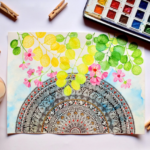We have all heard it plenty of times and I used to have questions going over in my head – if it is indeed inside of me, how can I reveal it – how come there had been times, being or staying happy can be quite a struggle – what does that even mean, that statement – joy is within me?
We live in an era where we have been made to believe time and again that happiness depends so much on what we own or achieve. The social and mass media, print and digital advertisements also people around us create a sense of false happiness that connects us directly with physical things and emotional attachments. That new Chanel bag, luxury holiday to Monaco, that new executive at work you have crush on or finding new love are just few examples.
Truth of the matter is, if we cannot be happy from within, regardless of what we own or achieve, we can never be truly joyful.
Yoga preaches and teaches the art of being joyful from within, with what is already existential from inside each and every one of us. Finding it requires some time, not to mention with clear heart and mind. Once it has been revealed, joy and happiness will be yours to stay, whatever the physical or outside circumstance is.
In Sanskrit, there are three words to describe levels of happiness and one or more of these levels pretty much exist in all of us. Some are fleeting or temporary joy, while others are more substantial.
Sukha is temporary pleasure that comes when you attain something that is of fleeting nature. It can only be felt when things are going your way, for example, acquiring that Cartier XL watch in rose gold. As easy as it comes, the feeling goes away rather quickly too, when the novelty wears off or when you set your eyes on a new time piece.
Santosha is contentment; the kind of feeling you and everything you own is enough without the need to have anything extra. Those who practice santosha are able to get back their peace of mind in a jiffy when irritation or agitation happens; all because they are contented.
Happiness that comes from the core, Mudita is the kind that sees beauty in everything, be in good or bad. This type of happiness is sometimes referred to as spiritual joy.
So having explained the different types of joy, lets look at ways to attain santosha and mudita.
Many times, we have heard the adage, gratitude begets abundance. By seeing the good in every little thing that surrounds us, we automatically get into gratitude mode, which in turn switches on happy feel. It has been said gratitude heightens quality of life and it is not at all a wonder.
One birthright bestowed to us, which has often been over-looked is regulation of breathing or pranayama as it is known in yogic context. Proper breathing is stress relieving, anxiety diminishing and also known to result in the feeling of immense happiness. There is a couple of breathing exercises, which has been used in yoga practice. Correct breathing techniques induces muscular relaxation, mental peacefulness and encourages the free flow of prana or living force, also known as chi.
Two of these are Sheetali Pranayama which is also known as cooling breath and Sheetkari Pranayama or hissing breath. In Sheetali Pranayama, cool breath is drawn into the body by rolling the tongue out to form a tube and inhaling air through it. Cool breath is known to effect brain centres associated with biological drives and temperature regulation.
On the other hand, Sheetkari Pranayama is done by hissing through the teeth. It has the same benefits as Sheetkali with an additional perk of keeping teeth and gums healthy. Coincidentally, science has pretty recently put a connection between mental happiness and oral health.
Meditation has been around since antiquity in various religion and beliefs. However, of late, science has also encouraged the use of mediation to aid in certain physical and emotional discrepancies. In theory, meditation is a practice whereby an individual focuses her mind on a thought, object or activity to encourage the free flow of mental calm and happiness. So, get on that comfortable chair or mat, close your eyes, breathe deep and meditate to happiness.
In any traditional religion, chanting is used to encourage clarity in the way we view our world, those on the outside and the one within us. Chanting transmits certain frequencies, which make us vibrate from the inside out. When this happens, we are automatically tuned in to our own joyful feel from within. Do know that it does not take much to OM your way to a happier you.
Having mentioned all of the above, we now come to the core factor of bringing true joy into your life. Yoga has been around for thousands of years.
Originating from ancient India, yoga brings together a group of physical, spiritual and mental practices, which aid in total wellbeing. Yoga helps reverse fight-or-flight tendencies into rest-and-digest mode. When your body is relaxed, rested and free of anxiety, what is there not to be happy?
Contrary to what we hear on day-to-day basis from all around, true happiness is indeed attainable. Fact of the matter is, no one ever needs anything to be happy. Joy and happiness is imbedded in each and every one of us; just a matter of sieving and looking deep into ourselves.
Let’s go back to how we were; when we first get here – let us all remind ourselves over and over – our joy is indeed our state of being.






